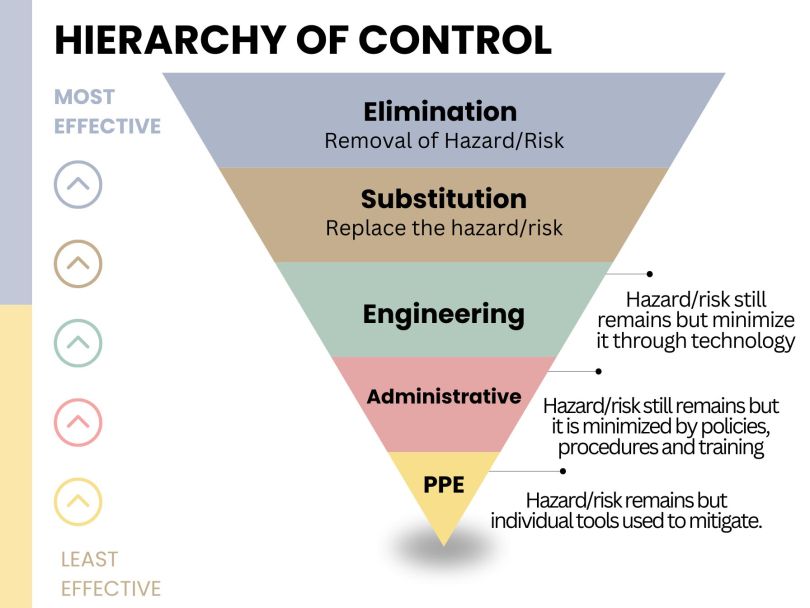In our results-driven society — where marketing professionals are constantly graded by return on investment, technology teams become factories turning out features at an alarming rate and sales professionals face monthly call and revenue targets — there is an underlying question: Are we overly fixated on outcomes?
A paradigm shift toward prioritizing process over results can yield far-reaching benefits, especially when managing risk and allowing for more consistent and favorable outcomes. Looking at the world of safety for inspiration, the hierarchy of controls is a framework we can apply to many industries, especially software development and technology.
The 5 levels of the hierarchy of controls
From most effective to least effective:
- Elimination
- Substitution
- Engineering controls
- Administrative controls
- PPE
What Is the Hierarchy of Controls?
The hierarchy of controls is a risk management framework that categorizes different approaches to control occupational hazards. Originally developed by the National Safety Council (NSC) in the 1950s, this hierarchy prioritizes control methods based on their effectiveness.
The hierarchy consists of five levels: elimination, substitution, engineering controls, administrative controls and personal protective equipment. Each level is a form of risk mitigation with the goal of moving from less effective, temporary solutions to more effective, permanent solutions.

Let’s look at an example. Like most managers, one of the first things I do when I join a new organization is spend some time shadowing my team. I was working for an organization that had onsite training with some customers. But when I arrived at the training, we didn’t have training materials, so the instructor had to improvise. This is a perfect example of a “personal protective equipment” solution extrapolated into the business world.
The instructor relied on their personal skills to deliver a great training, but if they weren’t as skilled and experienced, we could have been in real trouble. We needed a more consistent and stable solution. When we reviewed the process they had in place, we determined that it was heavy on user responsibility and light on process.
The organization needed to move up a rung on the hierarchy of controls from PPE to administrative control — changing the way people work, or in this case, the way they handled their trainings. One key learning is: People do not equal process.
Hierarchy of Controls Meets Agile Development
Agile methodology, which is widely adopted in the software development industry, emphasizes an incremental and iterative approach.

Using the hierarchy of controls framework in conjunction with an agile methodology maximizes results. Coming from the safety world into technology and development, I often merge the two into a new hybrid framework, one that promotes a process that allows for flexibility while simultaneously eliminating risk.
Elimination in Agile
In the hierarchy of controls, the goal is to constantly improve and eliminate hazards and risks, which is a concept that aligns with the key principle of continuous improvement in the agile framework. During stand-ups, sprint reviews and sprint retrospective, a key element is reflecting on the previous sprint or group work. During stand-ups or sprint reviews, a good scrum master will identify and eliminate inefficiencies.
Substitution in Agile
A core principle of the hierarchy of controls is replacing the hazards element with something less risky. This is similar to the core principle of adapting to change in agile methodology. When a particular technology, process or even methodology is proven to be a hindrance, truly agile teams are encouraged to substitute it with a more effective one; in other words, learn and adapt.
Engineering Controls in Agile
Agile practices, particularly in relation to software development, often involve implementing engineering controls by introducing automated testing, continuous system integrations and tools to enhance the development process. Similar to isolating people from the hazard in the hierarchy of controls, automation takes the risk of human error out of the equation.
Administrative Controls in Agile
Both agile and the hierarchy of controls emphasize effective and consistent communication, collaboration and planning. It is a key element of both methodologies, and it helps manage risk and eliminate errors by creating a culture that encourages everyone to respond to issues and changes promptly.
Personal Protective Equipment in Agile
While focusing on collective responsibility and collaboration, individual skills and competencies still play a crucial role. In an agile software development team, PPE equates to the skill and expertise of team members. These individual skills can act as a last line of defense, ensuring that even when other controls fail, the team can still perform. It should be the last line of defense, though, and you should strive to implement another control.
3 Benefits of Marrying Agile and the Hierarchy of Controls
A consistent process allows for three additional benefits: repeatability, elimination of bad habits and improved teamwork.
Repeatability
In technology and product development, a repeatable process is the heart of consistent progress. Learning from experience is as valuable as achieving a positive outcome. Incorporating principles such as the scientific method and agile iterative methods is instrumental in establishing a repeatable process.
The scientific method, with its emphasis on observation, experimentation and the formulation of hypotheses, serves as a foundation for meticulous problem-solving and learning from each iteration. This approach fosters adaptability, reduces variables and promotes a culture of continuous improvement.
Elimination of Bad Habits
Success attained by chance is sporadic and fleeting. To achieve sustained excellence and maximize results, identify and eradicate detrimental habits. A process-driven approach directs attention to the minutiae within our control, fostering an environment conducive to breaking free from counterproductive processes.
improvement of Communication and Teamwork
Complicated technology projects often involve diverse teams with specialized roles. Control what you can, and the results will follow. This ethos promotes individual responsibility within a team structure. Managers design the process and ensure compliance, while workers execute their roles. By emphasizing personal responsibilities, organizations can mitigate internal conflicts and office politics, fostering a sense of shared success.
A well-structured process also allows for predictable delivery dates. When all levels of the organization commit to a reliable timeline, it makes planning and resource allocation possible. This is particularly important in meeting client expectations and maintaining stakeholder confidence throughout the organization.
Aim for Long-Term Success
In combining agile methodology with the hierarchy of controls, organizations can create a comprehensive approach to risk management in the fast-paced and dynamic world of technology. The iterative nature of agile allows for continuous reassessment and improvement, while the structured hierarchy provides a framework for systematic risk mitigation. This integration can lead to more resilient processes, improved project outcomes and an adaptable company culture. By prioritizing process over results, organization can create a foundation for repeatable and predictable success.
This strategic implementation of control measures can pave the way for sustainable success. It’s not about abandoning the pursuit of outcomes but rather recognizing the importance of a well-managed, predictable and resilient process in achieving those outcomes. As you move forward, the challenge is to strike a balance between the pressure for immediate results and the need for a robust framework that ensures long-term success.





